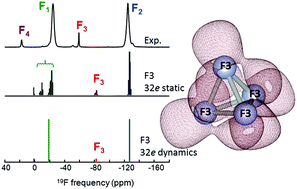Structure determination of Ba5AlF13 by coupling electron, synchrotron and neutron powder diffraction, solid-state NMR and ab initio calculations†
Abstract
The room temperature structure of Ba5AlF13 has been investigated by coupling electron, synchrotron and neutron powder diffraction, solid-state high-resolution NMR (19F and 27Al) and first principles calculations. An initial structural model has been obtained from electron and synchrotron powder diffraction data, and its main features have been confirmed by one- and two-dimensional NMR measurements. However, DFT GIPAW calculations of the 19F isotropic shieldings revealed an inaccurate location of one fluorine site (F3, site 8a), which exhibited unusual long F–Ba distances. The atomic arrangement was reinvestigated using neutron powder diffraction data. Subsequent Fourier maps showed that this fluorine atom occupies a crystallographic site of lower symmetry (32e) with partial occupancy (25%). GIPAW computations of the NMR parameters validate the refined structural model, ruling out the presence of local static disorder and indicating that the partial occupancy of this F site reflects a local motional process. Visualisation of the dynamic process was then obtained from the Rietveld refinement of neutron diffraction data using an anharmonic description of the displacement parameters to account for the thermal motion of the mobile fluorine. The whole ensemble of powder diffraction and NMR data, coupled with first principles calculations, allowed drawing an accurate structural model of Ba5AlF13, including site-specific dynamical disorder in the fluorine sub-network.



 Please wait while we load your content...
Please wait while we load your content...